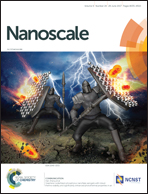Layered rare-earth hydroxide nanocones with facile host composition modification and anion-exchange feature: topotactic transformation into oxide nanocones for upconversion†
Abstract
Conical structures with hollow interiors, namely, nanocones (NCs), may exhibit better carrier transport properties than nanorods or nanotubes, which make them promising candidates for potential applications in optical/display devices, electronics and optoelectronics. Generally, conical structures belong to a metastable state between lamellar and tubular forms due to the extreme curvature causing the increase of internal strain energy. Therefore, it is very difficult to prepare NCs in high yield and purity under mild conditions. Here we firstly demonstrate a general strategy for the synthesis of layered rare-earth hydroxide (LRH) NCs intercalating dodecyl sulfate anions (C12H25SO4−, DS−) using hexamethylenetetramine (C6H12N4, HMT) hydrolysis. The rare-earth cations (RE3+) in the host layer can be conveniently modified and/or doped, resulting in a large family of monometallic (Y, Tb, Er), bi- (Y–Tb, Y–Er) and even tri-metallic (Y–Yb–Er) LRH NCs with adjustable ratios. Moreover, the DS−–intercalated LRH NCs can be readily modified with various inorganic or organic anions (e.g., NO3−, Cl−, and CH3COO−, etc.) through a conventional anion-exchange procedure, and the original conical morphology can be perfectly maintained. The anion-exchanged product, for example, NO3−-intercalated NCs, can be more easily and topotactically transformed into oxide NCs than the original DS−-intercalated form, exempt from the formation of rare-earth oxysulfates induced by the combustion of interlayer DS anions. Taking advantage of this protocol, tri-metallic (Y–Yb–Er) LRH NCs were anion-exchanged into the NO3−-intercalated form and subsequently calcined into Y2O3:Yb,Er oxide NCs, which showed efficient upconversion photoluminescence properties. The current strategy may become a general method for the designed synthesis of other related hydroxide and oxide NCs for a wide range of potential applications.



 Please wait while we load your content...
Please wait while we load your content...